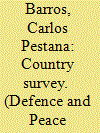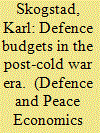| Srl | Item |
| 1 |
ID:
144119


|
|
|
|
|
| Summary/Abstract |
This paper is a survey of Angola’s defence sector and policy from 1992, the year the civil war ended, to 2012. Angola achieved its independence upon the Popular Movement for the Liberation of Angola (MPLA) defeating National Union for the Total Independence of Angola. Since then, fuelled by its rich natural resources, the country has grown steadily. The MPLA military forces were a central factor behind independence and maintain their central role to this day. Moreover, Angola’s support for African peace with monitoring military missions is a clear indication that the country aims to intervene in African security and military issues, with its military capabilities funded by oil revenues.
|
|
|
|
|
|
|
|
|
|
|
|
|
|
|
|
| 2 |
ID:
144114


|
|
|
|
|
| Summary/Abstract |
This paper examines the determinants of national defence budgets in the post-Cold War era employing a spatial econometric framework. Using data for 124 countries over a 16-year time period, I examine spatial relationships in defence spending to investigate how countries account for the military spending of other countries when setting their budgets. Using specially developed weighting matrices, the regression results indicate that defence budgets are positively spatially correlated. These results provide support for the use of ‘external’ factors when examining defence budgets over this time period. The importance of a country’s spatial location when setting its budget is further examined through the identification of regions of high and low defence spending.
|
|
|
|
|
|
|
|
|
|
|
|
|
|
|
|
| 3 |
ID:
144116


|
|
|
|
|
| Summary/Abstract |
This investigation re-examines the potential sources of positive externalities for the relationship between military spending and economic growth using recent advances in panel estimation methods and a large data-set on military expenditure. The investigation provides a new analysis on the relationship between conflict, corruption, natural resources and military expenditure and their direct and indirect effects on economic growth. The analysis finds that the impact of military expenditure on growth is generally negative as in the literature, but that it is not significantly detrimental for countries facing higher internal threats and for countries with large natural resource wealth once corruption levels are accounted for.
|
|
|
|
|
|
|
|
|
|
|
|
|
|
|
|
| 4 |
ID:
144118


|
|
|
|
|
| Summary/Abstract |
This paper provides a rationale for group support for political violence which does not provide a material benefit. Rabin’s (1993) theory of fairness is adopted to demonstrate that although group violence may not be a Nash equilibrium it may be a fairness equilibrium in a game containing psychological payoffs. For this to happen the material stakes must be perceived as low and psychological payoffs are expressive. Although the material stakes are actually high, members of each group may choose expressively to support the use of violence because the probability of being decisive is low. The paper also considers the possibility of peace emerging as a fairness equilibrium. This can only happen if each group perceives the other as making some sacrifice in choosing peace.
|
|
|
|
|
|
|
|
|
|
|
|
|
|
|
|
| 5 |
ID:
144120


|
|
|
|
|
| Summary/Abstract |
An extensive literature on the effect of military expenditures on economic growth yields conflicting results. However, a crucial issue that has not been investigated in this context is the possible effect of inequality. The impact of military expenditures on economic growth in Turkey has also received substantial attention. Yet, the majority of these studies are not constructed based on a structural model, but rather examine the causality between the variables in question. Considering these two shortcomings in the literature and the lack of consistent results, this study attempts to provide further evidence for the relationship between military expenditures and economic growth for the case of Turkey by considering income inequality within an augmented Solow growth model. Our findings for the 1963–2008 period show that while income inequality has a positive impact on economic growth, military expenditures have no significant effect.
|
|
|
|
|
|
|
|
|
|
|
|
|
|
|
|
| 6 |
ID:
144113


|
|
|
|
|
| Summary/Abstract |
Recent literature on whether military spending affects economic growth argues that the relationship may be a conditional one. We add to this literature by considering the role that ‘good institutions’ play in the effect of military spending on growth. Using data from a sample of over 100 countries from 1988 to 2010, our analysis suggests that the effect of military spending on growth is generally negative or zero at best, and this effect is mitigated in the presence of good economic and political institutions.
|
|
|
|
|
|
|
|
|
|
|
|
|
|
|
|
| 7 |
ID:
144117


|
|
|
|
|
| Summary/Abstract |
The paper builds a model to empirically test military expenditure convergence in a nonlinear set up. We assert that country A chooses a military strategy of catching up with the military expenditure of its rivals, subject to public spending constraints on public investments, including health and education, leading to decrease in long-term economic welfare. This implies nonlinear convergence path: only when the military expenditure gap between countries reaches the threshold level, will it provide incentives to catch up with rival’s military expenditures. We test this nonlinear catching up hypothesis for 37 countries spanning from 1988 to 2012. Results from individual nonlinear cross-sectionally augmented Dickey–Fuller (NCADF) regression indicate that 53% of countries converge to world’s average military expenditure: where 39% of countries converge to Germany; 33% of countries converge to China; 22% of countries converge to the USA, and 11% of countries converge to Russia. Interestingly, USA does not exhibit nonlinear military expenditure convergence toward world’s average level. For panel NCADF regression, the result suggests that on average, there is evidence for countries converging to USA’s military expenditure at 10% significance level. For the convergence to the world’s average, the statistical significance is at the 1% significance level.
|
|
|
|
|
|
|
|
|
|
|
|
|
|
|
|
| 8 |
ID:
144115


|
|
|
|
|
| Summary/Abstract |
Previous work has documented a negative correlation between internal conflict and state capacity. We attempt to shed light on mechanisms that underlie this relationship, using data for Colombian municipalities. We rely on identifying heterogeneous effects of different types of violent events on state capacity, taking advantage of variability across municipalities in the prevalence of specific manifestations of conflict and their intensity. Our findings suggest that events making civilians feel targeted affect the state’s capacity to collect taxes, while those reflecting a stronger military capacity of illegal armies, in particular their large-scale attacks, affect the state’s capacity to provide public goods.
|
|
|
|
|
|
|
|
|
|
|
|
|
|
|
|